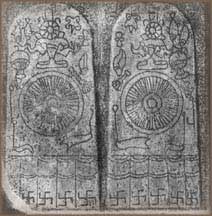
|
||||||
|
| ||||||
Popular Sinhalese Religion
The Sinhala Buddhist lay community accepts a large body of beliefs and religious rituals that are tolerated by Buddhist monks and integrated into Sinhalese religion. Many of the features of this popular religion come from Hinduism and from very old traditions of gods and demons. Sinhalese Buddhism is thus a syncretic fusion of various religious elements into a unique cultural system. There is a thin boundary between reverence for the Buddha's memory and worship of the Buddha as a god, and the unsophisticated layperson often crosses this line by worshiping him as a transcendent divine being. The relics of the Buddha, for example, have miraculous powers; the literature and folklore of the Sinhalese are full of tales recounting the amazing events surrounding relics. During the construction of a Buddha image, the painting of the eyes is an especially important moment when the image becomes "alive" with power.
At the Temple of the Tooth in Kandy, where the Buddha' s Tooth Relic is enshrined, rituals include elements from Hindu temple worship, such as feeding and clothing of the Buddha. In general, devotees believe that the Buddha's awakening makes him an all-powerful being, able to control time and space and all other supernatural beings. The Buddha is so pure and powerful that he does not intervene personally in the affairs of the world. That is the job of a pantheon of gods (deva) and demons (yakka) who control material and spiritual events. The Buddha never denied the existence of the gods or demons, but said that attention to these matters simply detracts from concentration on the path to enlightenment. The Sinhalese believe that the all-powerful Buddha has given a warrant (varan) to a variety of spiritual entities that allows them to regulate reality within set boundaries (sima). For help in matters of everyday life, the Sinhalese petition these spiritual entities rather than the Buddha.
Near many dagobas, or shrines of the Buddha, there are separate shrines (devale) for powerful deities. After reverencing the Buddha, devotees present prayers and petitions to the gods for help with daily life. The shrines for the gods have their own priests (kapurala), who practice special rituals of purification that allow them to present offerings of food, flowers, or clothing to the gods. Propitiation of demons occurs far away from Buddhist shrines and involves special rituals featuring the assistance of exorcists. The popularity of different deities changes over time, as people come to see particular deities as more effective in solving their problems. The principal gods include Vishnu (also a Hindu god, identified by Buddhists as a bodhisattva, or "awakening being," who helps others attain bodhi or awakening), Natha, Vibhisana, Saman (the god of Adams Peak and its vicinity), and the goddess Pattini (originally an ordinary woman whose devotion to her husband, immortalized in poetry, elevated her to divine rank). During the twentieth century, the god Vibhisana has declined in popularity while the god Kataragama, named after his hometown in Moneragala District, has become extremely powerful. The annual Kataragama festival brings tens of thousands of worshipers to his small town, including Hindus who worship him as a manifestation of the god Murugan and Muslims who worship at the mosque there. This common devotion to sacred sites and sacred persons is one of the most important features of popular religion in Sri Lanka. Another example of this religious syncretism is the cult of Sri Lanka's leading oracle, Gale Bandara Deviyo, who originally was a Muslim prince slain by the Sinhalese to prevent his accession to the throne. He is revered by Buddhists and Muslims alike at his shrine in the town of Kurunegala (in Kurunegala District). As transportation and communication facilities have expanded in modern Sri Lanka, there has been a big expansion of major pilgrimage sites that are jointly patronized by Sinhalese, Tamils, and Muslims, thus providing a commonality that may lead to closer cultural cooperation among competing ethnic groups. From Countries of the World by Peter R. Blood
|
| Living Heritage Trust ©2019 All Rights Reserved |

